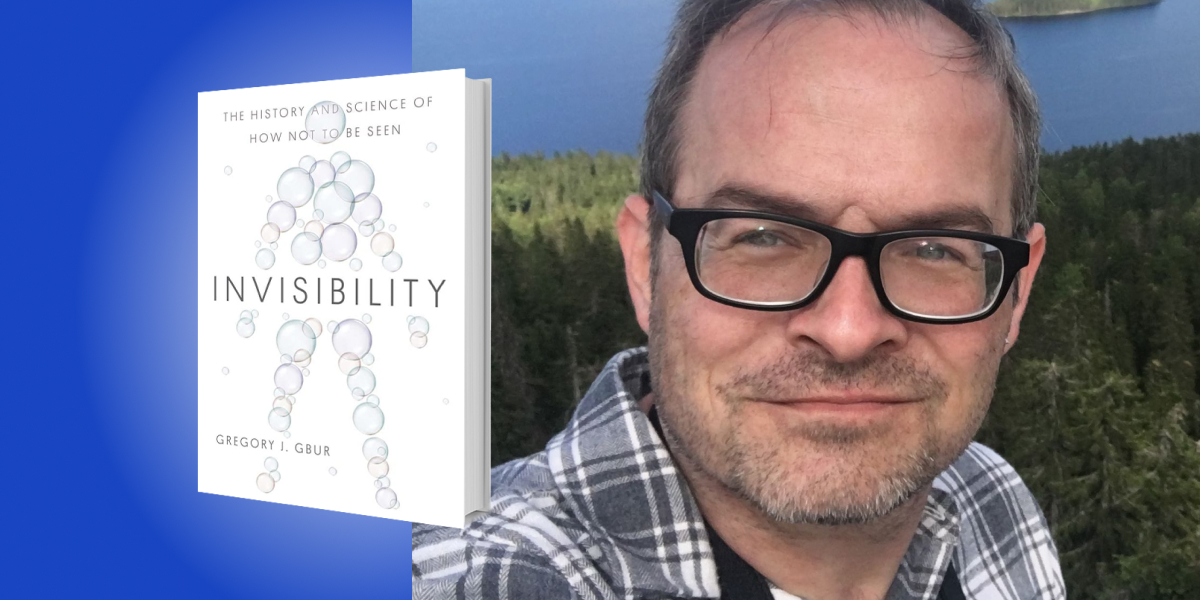Greg Gbur is a Professor of Physics and Optical Science in at the University of North Carolina at Charlotte. He is the author of Falling Felines and Fundamental Physics, and he writes two blogs on horror fiction, physics, and nature.
Below, Greg shares five key insights from his new book, Invisibility: The History and Science of How Not to Be Seen. Listen to the audio version—read by Greg himself—in the Next Big Idea App.

1. Invisibility has gone from science fiction to science fact.
It was long thought by physicists that perfect invisibility is impossible, but in 2006 two groups of researchers, one at the University of St. Andrews and the other a collaboration between Imperial College and Duke University, demonstrated theoretically that it is possible to make an optical invisibility cloak. These original cloaks were spherical objects made of materials tailored to guide light around a central hidden region as if it had encountered nothing at all. The principle is somewhat similar to how a mirage works on a sunny day: the heat of the pavement changes the density of the air above it, causing light from the sun to follow a curved path, making it look like there is water on the road.
It seemed at first that it would take a long time to experimentally demonstrate these surprising invisibility theories: in fact, I was interviewed by national newspapers about invisibility at the time and guessed that it might take five years or more to build a prototype. But less than six months later, the researchers at Duke University constructed a crude, imperfect version of an invisibility cloak—proving me wrong by four and a half years! Their prototype only worked for microwave radiation, and was not truly invisible in the colloquial sense of the word, but showed that the scientific principles are sound. Since then, there has been extensive research on a variety of strategies to make something invisible, research that continues to this day. We are still likely a long way from achieving true invisibility, if ever, but the research has led to new insights into light and unexpected applications.
2. Invisibility has been part of revolutionary discoveries in optical materials.
In the mid-1990s, a research company in the United Kingdom created a new carbon-based material that seemed really good at absorbing radar waves and could be used to make battleships harder to detect. The company had only one small problem: based on the known properties of carbon, they could not explain why their material worked so well.
They hired John Pendry, a physicist at Imperial College, to solve the mystery. Pendry discovered that the material gained its remarkable properties from its microscopic structure: the carbon was woven into a forest of tiny tangled threads that would trap the radar waves that encountered it.
“Pendry was later one of the physicists who demonstrated in 2006 that invisibility cloaks may be possible.”
Pendry realized that he could control the optical properties of any material by controlling its microscopic structure, and he referred to such new materials, which possess properties not found in nature, as “metamaterials.” One of his first demonstrations of metamaterials was showing, in 2000, that one could make a lens out of metamaterials that would not only be perfectly flat, unlike the curved lenses used in eyeglasses and cameras, but would also be able to form an image that is in principle perfect, with no resolution limit. Pendry’s paper led to an outcry from physicists who rushed to prove him wrong, but his work has held up theoretically and experimentally.
Pendry was later one of the physicists who demonstrated in 2006 that invisibility cloaks may be possible. The discovery of metamaterials has changed the field of optics. Historically, optics asked the question, “What can light do?” and now the question has changed to, “How can we make light do whatever we want it to?” Longstanding rules and restrictions based on the known properties of light are now being broken, or at least bent, through the use of metamaterials.
3. Metamaterials and cloaking have led to even stranger possibilities for optics.
To design invisibility cloaks, theoretical physicists borrowed some of the mathematical tools used in Einstein’s general theory of relativity. In general relativity, gravity warps space and time, causing light to bend around massive objects. In optical science, researchers realized that they could design optical materials that can effectively act like they are warping space.
In an invisibility cloak, the material effectively bends light away from the cloaked region, leaving the region hidden. But even stranger possibilities have now been demonstrated. It has been shown that it is possible to make an optical wormhole that acts as an invisible tunnel that conveys light from one end of a region of space to another. These same design tools have been used to make structures that mimic black holes in the way that they trap light, allowing scientists to test some of the strange predictions that have been made about the behavior of black holes.
“It has been shown that it is possible to make an optical wormhole that acts as an invisible tunnel that conveys light from one end of a region of space to another.”
Other researchers have shown that it is possible to make an invisibility cloak that does not need to surround the hidden object, but can stand next to it: imagine hanging your invisibility cloak on a coat rack, but you still remain invisible! Building upon this curious discovery, the same researchers imagined putting such a cloak next to a thin wall and using the cloak to make part of the wall invisible. In essence, they used an invisibility cloak to make the wall see-through. The implications of being able to make any wall see-through are a bit disturbing, but the work has only been done using computer simulations, and the wall that was tested was less than a millimeter thick, so our privacy at home is safe for now. Most of these ideas are still only theoretical but show that cloaking physics leads to many strange surprises.
4. There is a long history of invisibility in science and science fiction.
Though invisibility has truly only become mainstream in the last 20 years, many people over more than a century have pondered how invisibility might be possible. The first story to attempt to scientifically explain invisibility was written in 1859 by Irish-American author Fitz James O’Brien. O’Brien wrote a story about a boarding house haunted by an invisible monster and attempted to justify how such a monster might exist using the little that was known about optics at the time.
As optical science progressed, science fiction authors invented more sophisticated explanations of how invisibility might work, and these explanations were often inspired by the science of the time. When H.G. Wells wrote his classic novel The Invisible Man in 1897, he imagined that the invisibility was caused by exposure to a new form of invisible radiation like X-rays. The discovery of X-rays in 1895 convinced many people that scientists would soon be peeking through their clothing, and some people even started selling X-ray-proof underwear.
In their writings, many science fiction authors even came close to guessing at how modern invisibility devices work. A 1962 story by Algis Budrys imagined an “Invisible Weapons Carrier,” which used fiber optic cables to guide light around the pilot of the vehicle and send it on its way. This functioned much like how modern invisibility cloaks use more sophisticated materials to guide light around the cloak’s core. While science fiction authors speculated, scientists were also finding ideas of invisibility important in a number of unexpected problems.
“As optical science progressed, science fiction authors invented more sophisticated explanations of how invisibility might work.”
In the early years of the 20th century, invisibility was considered a key component in early models of atoms and other fundamental particles, before being supplanted by quantum physics. Invisibility has also played a role in computational imaging problems like computed tomography, also known as a CAT scan. In tomography, the concern was that the existence of invisible objects would indicate that a medical image is not showing everything that is really going on in a patient.
5. Invisibility is about more than hiding!
In 2003, Susumu Tachi at the University of Tokyo demonstrated an “invisible coat,” in which a person was made to appear see-through when viewed from a certain angle. Professor Tachi suggested that his “retro-reflective projection technology” could be used to simplify some tasks by hiding things we don’t want to see. He imagined it being used as an aid in surgery: a projection of a patient’s internal organs on their skin could aid surgeons in making incisions. He also imagined making the interiors of cars or aircraft see-through, to allow a driver or pilot to have complete visibility of everything around them without obstruction.
Much more recently, physicists and engineers have applied the principles of light wave cloaking to other types of waves. A water wave cloak could be designed to protect offshore ocean platforms from damaging water waves, and a seismic cloak could be designed to protect buildings from earthquake waves. A crude test of this seismic protection was done in 2014 by French researchers and gave promising results. They have even suggested that entire city blocks might be made earthquake-resistant by designing all the buildings to form a seismic metamaterial. The future of invisibility may be in protecting things rather than hiding things.
To listen to the audio version read by author Greg Gbur, download the Next Big Idea App today:































